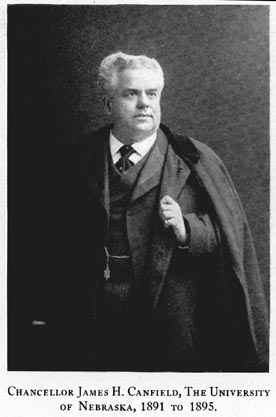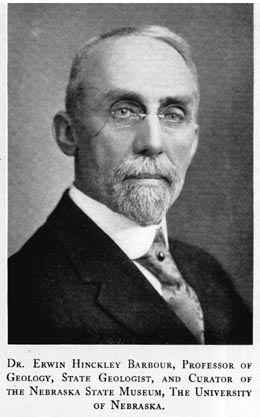[70]
THE MORRILLS AND REMINISCENCES

![]()

|
© 2002 for the NEGenWeb Project by Pam Rietsch, Ted & Carole Miller.
|
||||
NEGenWeb Project
Resource Center
On-Line Library
the acts of Brigham Young and his many wives. Most of these wives lived in one house not far from the Tabernacle. The house was divided so that each wife had an apartment. It was said that one day Brigham Young met a very dirty looking boy on the street near his residence. He scolded him about his untidy appearance and told him to go home and tell his mother it was a disgrace to the Mormons to allow such a looking child on the streets. As the boy started away, Brigham asked, "Whose boy are you?" He answered, "I am Brigham Young's son."
The Mormon Church established in Salt Lake City a theater and several dancing halls. I asked if the Church people believed that theater-going and dancing were debasing to the morals of the young people. A Mormon elder answered, "Young people cannot be kept away from places of amusement, and if they will patronize such places, we believe it the duty of the Church to own and regulate them by suppressing immoral shows in the theater. As for dancing we think, that under the management of the Church, there is nothing wrong about it, in fact, we believe it to be an innocent amusement, and therefore, ask our young people to attend Mormon places of amusement, and very seldom are they seen elsewhere."
While living in Salt Lake City, Gov. Nance and I visited the great silver mine at Park City, owned by Hearst and Hagen. We were the guests of Mr. Chambers, superintendent of the mine. There were three hundred miners employed and we were told that
[67]
the mine had already paid millions of dollars in dividends to the owners. There was a dining room of sufficient capacity to seat, at one time, all the employees and officials. The food was of the best the market afforded. The miners were paid from three to five dollars per day of eight hours. There were three shifts of laborers, and all expressed themselves as being well-satisfied. While there we took a ride from the top of the mountain down into the valley on an ore car. These cars were run in trains, three cars constituting a train. They came down by gravity. The engineer sat on the rear car with the brake at his right. There were ropes tied to the two front car brakes, which were held by the engineer like lines on horses. The grade was fearfully steep and the turns in the road very short. We came down at almost lightning speed and on the way saw several cars that had run off the track and rolled one hundred feet or more down the bank. This was certainly the ride of my life, and no amount of money could induce me to repeat it. We remained at the mine three days and felt ourselves greatly indebted to Mr. Chambers. He explained everything about the mine and did all in his power to make our visit interesting.
After several months' stay in Salt Lake City, we decided to look over Oregon, Idaho, and Washington. We visited that part of Idaho known as the Cammus Prairies. Idaho is a very dry state, with little water for irrigation, but strange as it may seem, the Cammus Prairies, although surrounded by arid lands, have
[68]
sufficient rainfall for growing crops. From Boise City we went over a large part of eastern Oregon, and stopped a week at Malhuer Lake, about one hundred and fifty miles from the Oregon Short Line railroad. Eastern Oregon, like Idaho, is very dry. This state had formerly voted land grants to assist in the construction of wagon roads. These land grants overlapped each other, running in many different directions, causing confusion in the titles to land. We next visited Walla Walla, and from there went over the Palouse country where the principal crop is wheat. That section is hilly and rough but very fertile. We saw big crops of wheat growing on land so rough and hilly that, to us, it seemed impossible to run a harvester over it. When the wheat was threshed it was hauled in sacks to the nearest railroad station and piled up in immense quantities on platforms made for this purpose, where it remained, with no covering to protect it, until it was loaded on cars for shipment to market. At that time, fine land, located fifty to seventy-five miles from Walla Walla, could be purchased at five to ten dollars an acre. From Walla Walla we went to Seattle, then a city of twenty thousand people. We were told that James J. Hill with the Great Northern railroad was doing everything possible to make Tacoma the metropolis of the Puget Sound country. Property was cheap in Seattle, and tide-water lands near the city, now worth millions, then were of little or no value. We visited Lake Washington, a beautiful body of fresh water, five miles from Seattle. At Tacoma we visited
[69]
the mills and factories and found one saw mill that was turning out eight hundred thousand feet of lumber every twenty-four hours. Our visit was during the rainy season and for that reason neither Seattle nor Tacoma had any attractions for Governor Nance or myself. We next went to Salem, Oregon, and from there to Grays Harbor, Oregon. Here they informed us that the rainfall during three or four months of the rainy season was sometimes over one hundred inches. We then returned to Salt Lake City by way of San Francisco.
DROUGHT AND PANIC
On my return to Nebraska, in 1890, I settled in Stromsburg, where, soon afterwards, I purchased the Farmers & Merchants Bank.
Nebraska had been favored with good crops and the price of land advanced to thirty-five and forty dollars an acre. In the year 1893 crops in Nebraska were almost totally destroyed by drought and hot winds. Then came the panic and financial stress, which paralyzed business. In 1894 Nebraska was doomed to have another crop failure. Farmers were obliged to ship in grain and even hay to feed their stock; many sacrificed their live stock by selling at very low prices. Some farmers shot their stock hogs to prevent their starving. Financial conditions grew worse and the entire state was almost in the grip of actual famine. Values were greatly reduced, merchants and banks failed. In Lincoln all banks with the exception of three went out of business or failed. Farmers could not